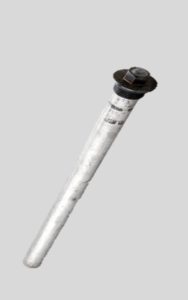
The anode rod or sacrificial anode is the one part of a water heater that has the biggest effect on the life of a water heater. Because of the materials that it is made of, an anode rod will slowly rust and corrode away and, by sacrificing itself, will prevent the water heater tank itself from rusting and corroding. In this way, anode rods can significantly increase the life of the water heater.
From what I have observed, very few people bother to replace the anode rods in their water heaters.
Through this post, I hope to show you how critical it is to do this every few years, as it will likely double the life of your water heater and save you a lot of money.
In this blog post, I will explain what an anode rod is, how important it is to have a good anode rod in your water heater, how anode rods work, how to check an anode rod, and how to replace the anode rod in your water heater.
So, let’s get started.
What is an Anode Rod?
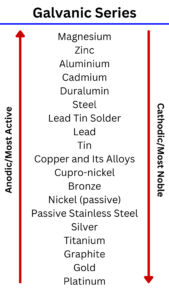 A water heater anode rod is a metal rod typically made of magnesium, aluminum, or an aluminum/zinc alloy. They are used in almost all water heaters.
A water heater anode rod is a metal rod typically made of magnesium, aluminum, or an aluminum/zinc alloy. They are used in almost all water heaters.
The anode rod is normally three to four feet long, and is usually installed through the top of the water heater and goes down into the water, reaching almost to the bottom of the tank.
Maintaining a good anode rod in a water heater can double the life of the average water heater. If the anode rod is used up so that it no longer functions, the water heater tank will begin to rust and corrode.
A rusting and corroding water heater tank will quickly become a leaking water heater which will have to be replaced. A new anode rod typically costs about $30 – $40, while a new water heater installed by a plumber can cost $1000 or more.
As you can see, it is MUCH cheaper to maintain your current water heater than to replace it.
How Does An Anode Rod Work?
An anode rod works through a process called galvanic action. Anytime two dissimilar metals (such as copper and steel, aluminum and tin, etc.) are in contact with each other and when those two metals are in the presence of an electrolyte (a conductive liquid such as water), galvanic action or galvanic corrosion will occur.
Examples of this are a rusting aluminum roof when steel screws are used, or a corroding water line when copper pipe is connected directly to a piece of galvanized steel pipe.
Only one of the two metals can corrode through the process of galvanic corrosion. It is the metal that has the lower galvanic potential (higher potential to corrode) that will corrode, while the other metal will be protected.
It is an electrochemical reaction in which the corroding metal essentially slowly “dissolves” in the water while electrons are passed from one of the metals to the other metal.
(This is basically the same process by which lead car batteries work.)
The anode rod in a water heater has the lower galvanic potential than the steel tank, so it is the metal that “dissolves” or corrodes in the water in order to protect the steel tank from corroding.
How Often Should Anode Rods Be Replaced?
There are many factors that affect how long an anode rod will last, but the average is about three years. Some of the factors that affect the length of time the rod will last are the following:
1. The quality of the water, such as how hard it is and the types of contaminants (calcium, magnesium, etc) that are in the water.
2. If a water softener is used.
3. How much hot water is used in the home.
4. How hot the water is.
5. What type of anode rod is used.
6. How well the system is maintained, such as how frequently the water heater is flushed.


The rod on the right is shown still installed in a water heater that I cut open in a video. There is nothing left of this rod but the wire that the magnesium used to be attached to. It had probably been in that water heater since the water heater was installed about 15 years ago.
How to Check an Anode Rod?
If you are a do-it-yourselfer, you can probably check the anode rod in your water heater. Otherwise, you may need to call a plumber to do it for you.
If you want to do it yourself, here’s what you need to do.
1. Turn off the power (electricity or gas) to your water heater. On a gas water heater, you can turn the knob to “pilot” to avoid having to relight it when you are done.
2. Shut the water supply valve on the cold water line to your water heater.
3. Open and leave open a hot water faucet in your house to relieve pressure on the hot water system.
4. Locate the hex head of the anode rod on top of your water heater. Sometimes they are under a plastic cap. It is like a large hexagonally shaped nut about 1 inch across.
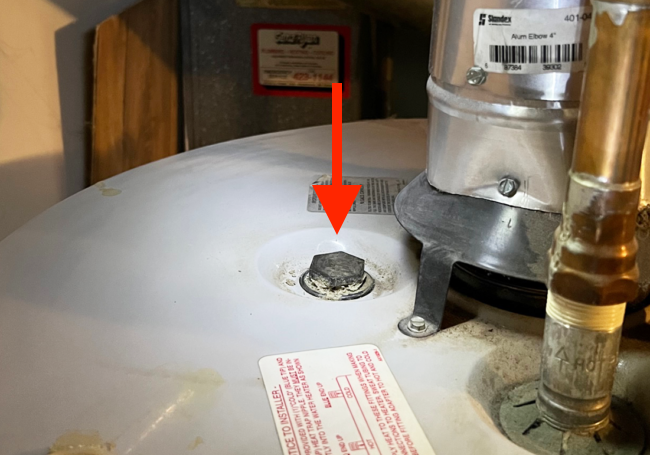
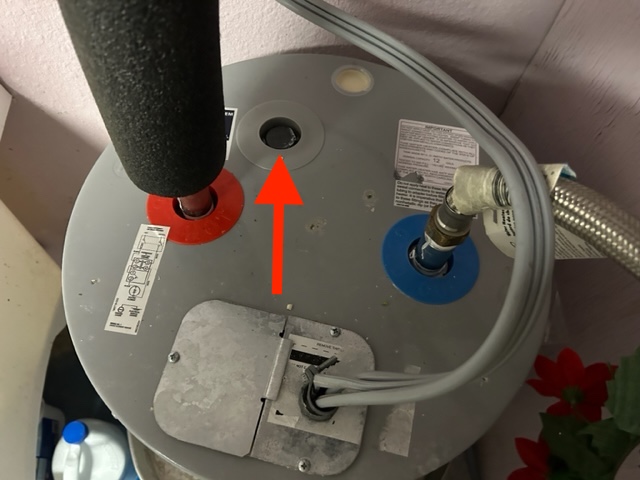

5. Use a 1 1/16 inch socket on the rod to unscrew it. NOTE: If the water heater is several years old and the rod has never been removed before, then it could be difficult to remove. Some lubricating oil or WD-40 may make it easier to remove. I have even seen where an impact wrench had to be used before the anode rod would start turning. A cheater bar on the socket wrench also may help. ANOTHER NOTE: The weight of the water in the water heater should be sufficient to hold the water heater in place while you try to unscrew the rod, but be careful that the water heater doesn’t turn and loosen a water line which could start leaking.
6. Beware – the rod will be as hot as you keep your hot water. Lift the rod straight up out of the water heater. NOTE: You don’t have to remove it completely – just pull it out a couple of feet and look at it. If it is eaten up or looks just like a piece of wire, then it is definitely time to replace it. Some manufacturers say that if it is 50% gone, then it is time to replace it.
7. If the water heater and rod are several years old, then it will likely need to be replaced, but in the event that the anode rod does not need to be replaced, then you can simply repeat the process above in reverse to re-install the rod back into the water heater. It is a good idea to put Teflon pipe thread sealant on the threads of the rod before screwing it back into place. DO NOT use Teflon tape as this can prevent a proper electrical connection which will prevent the anode rod from working properly.
8. If the rod needs to be replaced, then see the process below which is almost identical to this procedure for checking the anode rod.
How to Replace an Anode Rod?
If you are a do-it-yourselfer, you can probably replace the anode rod in your water heater. Otherwise, you may need to call a plumber to do it for you.
If you want to do it yourself, here’s what you need to do.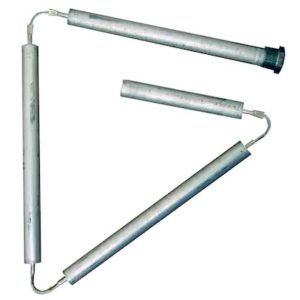
1. Obtain a new replacement anode rod. You can get one at most hardware stores, Amazon, etc. Make sure you find one that will match you water heater. If you have a short, fat tank, for example, a normal length rod will probably not work for you. If you do not have about 4 feet of headroom above your water heater, you can purchase a segmented anode rod which is flexible – sort of like a string of sausages. This will be much easier to install into your water heater.
2. Turn off the power (electricity or gas) to your water heater. On a gas water heater, you can turn the knob to “pilot” to avoid having to relight it when you are done.
3. Shut the water supply valve on the cold water line to your water heater.
4. Open and leave open a hot water faucet in your house to relieve pressure on the hot water system.
5. Attach a water hose to the drain valve on the bottom of your water heater and drain a gallon or two of water from your water heater. Since the new anode rod will be larger (volume-wise) than the old, used-up rod, it will displace more water than the old rod, and will cause some water to spill out of the water heater when you insert it into the water heater. (If your water heater is located somewhere where spilling a gallon or so of water on the floor will not cause any problems or damage, then you can skip this step.)
6. Locate the hex head of the anode rod on top of your water heater. Sometimes they are under a plastic cap. It is like a large hexagonally shaped nut about 1 inch across. (See photos in the section above.)
7. Use a 1 1/16 inch socket on the rod to unscrew it. NOTE: If the water heater is several years old and the rod has never been removed before, then it could be difficult to remove. Some lubricating oil or WD-40 may make it easier to remove. I have even seen where an impact wrench had to be used before the anode rod would break loose and start turning. A cheater bar on the socket wrench also may help. ANOTHER NOTE: The weight of the water in the water heater should be sufficient to hold the water heater in place while you try to unscrew the rod, but be careful that the water heater doesn’t turn and loosen a water line which could start leaking.
8. Beware – the rod will be as hot as you keep your hot water. Lift the rod straight up out of the water heater. NOTE: You may not have enough headroom above the water heater to lift the rod completely out of the water heater. In this case, you will have to bend the portion of the rod that you have pulled out of the water heater to give yourself more room to lift the rest of the rod out of the water heater. Do your best to keep the portion of the rod that is still in the water as straight up and down as possible so that the rod does not hit, break, scrape or otherwise damage any other component inside the water heater.
9. Before installing the new anode rod, it is a good idea to put Teflon pipe thread sealant on the threads of the rod before screwing it into the water heater. DO NOT use Teflon tape as this can prevent a proper metal-to-metal connection between to rod and the tank which will prevent the anode rod from working properly.
10. Carefully insert the new rod into the water heater and get the threads started by hand. Then use your wrench to finish screwing it in, and make it snug.
11. Slowly open the water supply valve to the water heater checking around the hex head for any signs of leaking. Once no leaks are observed, or any leaks are dealt with, fully open the water supply valve.
12. Shut the open hot water faucet inside the house.
13. Shut the breaker or set the thermostat back to your desired temperature.
That’s it. You are done.
What is the Best Material to use for Anode Rods?
The two main factors that affect anode activity (how fast it corrodes) are the material that the anode if made of, and the chemistry of the water.
Anode Material
Magnesium is the most-used anode material given its ability to protect the steel tank better than other materials. It corrodes more readily than aluminum does. In some situations where water is more conductive (such as when a water softener is in use) or when the water has a lower pH, the corrosion of the anode rod is accelerated so in those cases, aluminum would be the better choice.
Water Chemistry:
Water chemistry not only affects conductivity and how quickly the anode is consumed, but it can also contribute things like the “rotten egg smell” that sometimes occurs in water heaters.
Also, if there is a lot of magnesium in the water, then aluminum is normally a better choice for the anode rod.
Basically, magnesium normally does a better job protecting the steel tank, but may be consumed too quickly in some cases.
Aluminum anode rods are typically less expensive than magnesium anode rods.
Summary
Too many people neglect their water heaters. They have the mentality of “out of sight, out of mind.” This is an expensive mentality. A little bit of attention and maintenance can significantly prolong the life of the average water heater.
Draining your water heater once a year, and changing out the anode rod every three years or so will cost you a couple of hours and less than $50, but can probably double the life of a $1000 (or more) water heater.
In this post I have attempted to show you the imporatace of replacing the anode rod in your water heater regularly. I have explained to you how to check the anode rod and to replace the anode rod in your water heater. It is not that difficult to do, and it can save you a significant amount of money.

